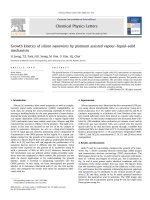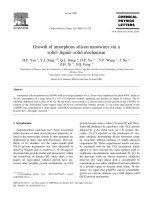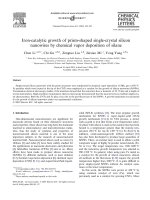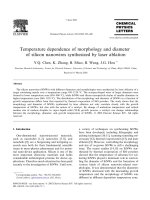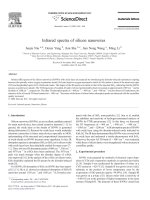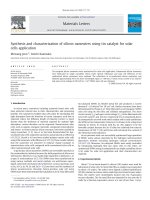- Trang chủ >>
- Khoa Học Tự Nhiên >>
- Vật lý
Growth kinetics of silicon nanowires by platinum assisted vapour–liquid–solid mechanism
Bạn đang xem bản rút gọn của tài liệu. Xem và tải ngay bản đầy đủ của tài liệu tại đây (307.25 KB, 4 trang )
Growth kinetics of silicon nanowires by platinum assisted vapour–liquid–solid
mechanism
H. Jeong, T.E. Park, H.K. Seong, M. Kim, U. Kim, H.J. Choi
*
Department of Materials Science and Engineering, Yonsei University, Seoul 120-749, Republic of Korea
article info
Article history:
Received 9 April 2008
In final form 5 November 2008
Available online 12 November 2008
abstract
The growth kinetics of Si nanowires produced by a vapour–liquid–solid (VLS) mechanism in conjunction
with Pt and Au catalysts, respectively, was investigated and compared. Pt was employed as a VLS catalyst
for single-crystal Si nanowires in a SiCl
4
-based chemical vapour deposition process. The growth rates
were higher with Pt than with Au under all processing conditions. The activation energy was measured
as 80 and 130 kJ/mol with the Pt and Au catalysts, respectively. The present results suggest that the rate-
determining step is the incorporation of Si atoms in the lattice at the liquid/solid interfaces and, further-
more, the metal catalysts affect this step, resulting in different activation energy.
Ó 2008 Elsevier B.V. All rights reserved.
1. Introduction
Silicon (Si) nanowires have novel properties as well as comple-
mentary metal oxide semiconductor (CMOS) compatibility. As
such, they are among the most promising materials in terms of
serving as building blocks for the next generation of nano devices.
Among the many available methods to grow Si nanowires, chem-
ical vapour deposition (CVD) processes via a vapour–liquid–solid
(VLS) mechanism have been widely used since Wagner and Ellis
contrived this process in 1964 [1] for Si whiskers. The bulk of re-
search in this area has focused on the use of an Au catalyst to
grow Si nanowires. However, Au acts as a deep-level impurity
in the Si band gap [2], thereby preventing direct integration of
Si nanowires in the CMOS process. In this regard, Pt is a good can-
didate catalyst for the growth of Si nanowires via the VLS mech-
anism. It is known that Pt does not yield an undesirable electronic
effect in Si [3], and thus will not degrade the performance of Si
nanowire devices even if it diffuses into the nanowires. Some
studies have reported on the growth of Si nanowires using Pt
with a precursor of SiH
4
or SiCl
4
[4–6]. However, because the
VLS mechanism was not utilized and/or single-crystalline nano-
wires were not employed in these studies, the processes are not
ideal for device application or for understanding the growth
kinetics, which is essential to integrating nanowires into the
CMOS process. In this study, we have investigated the growth
kinetics of Si nanowires fabricated with Pt via the VLS mecha-
nism, and compared the results with those for nanowires fabri-
cated with Au.
2. Experimental
Silicon nanowires were fabricated by the conventional CVD pro-
cess using silicon tetrachloride (SiCl
4
) as a precursor. Using an E-
beam evaporator, Si (111) wafers were coated with Au and Pt as
catalysts, respectively, to a thickness of 5 nm. Portions of the cata-
lyst-coated substrates were then placed in a quartz tube inside a
CVD furnace. As the furnace temperature was increased, flow of di-
luted H
2
(100 standard cubic centimeter per minute, sccm) and Ar
(100 sccm) gas was initiated. SiCl
4
was carried into the reactor
quartz tube by H
2
that had been passed through a bubbler that
maintained SiCl
4
in a liquid state at 0 °C. To investigate the growth
kinetics, processing time (1, 5, 10, and 20 min), temperature (900–
1100 °C), and SiCl
4
/H
2
concentration (5, 10, 15, and 20 sccm) were
manipulated.
3. Results and discussions
Both Pt and Au successfully catalyzed the growth of Si nano-
wires. Fig. 1 shows scanning electron microscopy (SEM) images
and transmission electron microscopy (TEM) observations. The
SEM images shown in Fig. 1a and b reveal Si nanowires with diam-
eters of 100 nm and lengths of several
l
m. The Si nanowires in
Fig. 1a and b were grown under identical conditions with the
exception of the metal catalyst that was used. The figures show
that the nanowires grew vertically on the substrate in both cases.
It is well known that the epitaxial relationship between substrate
and nanowires can be attributed to the vertical growth of nano-
wires [7,8] and thus, similar to Au, Pt yields epitaxial interfaces
between the nanowires and Si substrate. The SEM image also
shows that the Si nanowires grown using Pt was far longer than
those grown using Au.
0009-2614/$ - see front matter Ó 2008 Elsevier B.V. All rights reserved.
doi:10.1016/j.cplett.2008.11.022
* Corresponding author. Fax: +82 2 365 5882.
E-mail address: (H.J. Choi).
Chemical Physics Letters 467 (2009) 331–334
Contents lists available at ScienceDirect
Chemical Physics Letters
journal homepage: www.elsevier.com/locate/cplett
The TEM images and selected area electron diffraction (SAED)
patterns in Fig. 1c and d clearly show that the Si nanowires are sin-
gle crystalline, without any structural defects. Alloy globules of
Pt–Si or Au–Si were formed at the tips of the nanowires. An energy
dispersive spectroscopy (EDS) analysis across the catalyst-
nanowire interface at the tip of an individual nanowire clearly
shows that Pt has operated as a VLS catalyst, like the Au catalyst
(Fig. 1e and f). Note that a Si-rich globule was formed when using
Fig. 1. Synthesis of Si nanowires using Au and Pt as catalysts. (a) Vertically-aligned Si nanowires using Au. (b) Vertically-aligned Si nanowires using Pt. Si nanowires using Pt
are longer than those using Au. (c) HRTEM image of Si nanowire using Au. (d) HRTEM image of Si nanowire using Pt. Both were single crystal. (e) EDS line mapping of Si
nanowires using Au catalyst. (f) EDS line mapping of Si nanowires using Pt catalyst. (g) HRTEM image of interfaces between the globule and nanowire grown with Pt. Arrows
indicates the platinum silicides showing different lattice fringe to Si. (h) HRTEM image of interfaces between the globule and nanowire grown with Au.
332 H. Jeong et al. /Chemical Physics Letters 467 (2009) 331–334
the Pt catalyst, while an Au-rich globule was formed when using
the Au catalyst. One reason for this compositional difference may
be the differential solubility of Si in Pt and Au. Specifically, the sol-
ubility of Si in Au is 18.6 at% [9], whereas in Pt it is as high as 67 at%
[10] at their eutectic points. Therefore, it is possible that the Pt cat-
alyst under a liquid state has a Si-rich composition. The composi-
tional differences may also be attributable to the formation of
platinum silicide upon cooling. We characterized the catalyst glob-
ule/nanowires interfaces by HRTEM and observed platinum silicide
layers showing different lattice fringes from Si in the nanowires
grown with Pt (Fig. 1g). However, no such layers were observed
at the interfaces with Au (Fig. 1h).
Fig. 2 shows the length of the Si nanowires according to the
holding time for the Pt and Au catalysts, respectively, at 1000 °C
with a SiCl
4
flow rate of 20 sccm. The growth rate of the Si nano-
wires was constant with time in both cases. This indicates that Pt
maintains a catalytic role throughout the growth of the Si nano-
wires, as does Au, without loss of components by chemical reaction
or evaporation. Thus, it has been demonstrated that Pt is a stable
catalyst for the VLS mechanism. The growth rate of Si nanowires
with Au was 5.20
l
m/min while Pt showed a 2.28 times faster
growth rate (11.86
l
m/min), with a 20 sccm SiCl
4
flow rate in both
cases.
Fig. 3 shows the growth rate of the Si nanowires with the flow
rate of SiCl
4
at 1000 °C. The holding time was fixed at 20 min. The
figure shows that the growth rate with Pt is higher than that with
Au under all flow rates of SiCl
4
. It also shows that the growth rate
decreased with the SiCl
4
flow rate and was nearly saturated at a
flow rate of 20 sccm. The VLS process consists of four main steps:
(1) mass-transport in the gas phase; (2) chemical reaction on the
vapour–liquid interface; (3) diffusion in the liquid phase; and (4)
incorporation of Si atoms in a crystal lattice [11–14]. Identification
of the rate-determining step among these steps is important for
understanding the kinetics. However, this is very complicated,
since three phases, two interfaces (that is, vapour–liquid and
liquid–solid interfaces), and chemical reactions are involved [11].
Nevertheless, it may be possible to draw some insights based on
previous and current studies.
Among those steps, step (3) can be excluded, since Si atoms dif-
fuse in liquid metals very quickly [12] and thick nanowires or
whiskers do not grow more slowly than thin nanowires while
the shape of the liquid droplet is maintained to be almost hemi-
spherical, and thus holds longer diffusion length [11]. Step (1)
can also be excluded since the diffusion coefficient in the gaseous
phase usually follows a power law D = D
0
(T/T
0
)
n
(P/P
0
), n = 1.5–2
[11,12], and thus the growth rate should follow the power law.
However, this is not the case in the present study as well as in pre-
vious studies [11–14].
The primary evidence for regarding step (2) as the rate-limiting
step is that the growth rate is proportional to the partial pressure
of reactant gas. However, this does not fully support the argument
since the growth process consists of two activated steps in series
[11]. The dependence of the growth rate on the reactant vapour
concentration is not in itself evidence that any of them is the
rate-determining step. Rather, it simply reflects the dependence
of the growth rate on supersaturation. Furthermore, as shown in
Fig. 3, the growth rate is saturated at a high SiCl
4
flow rate of
20 sccm; i.e., in the present growth conditions, the growth rate is
not proportional to the partial pressure of reactant gas. Therefore,
the rate-determining step would be step (4), incorporation of Si
atoms in a crystal lattice. Accordingly, Pt would affect this step,
resulting in a different growth rate.
We determined the activation energy for the growth of the Si
nanowires, as shown in Fig. 4, by plotting the growth rate with
0 5 10 15
0
50
100
150
200
Length (µm)
Time
(
min
)
Fig. 2. Length of Si nanowires using Au and Pt versus time at holding temperature
of 1000 °C.
0 5 10 15 20
0
50
100
150
Growth rate (µm/min)
SiCl
4
/H
2
(sccm)
Fig. 3. Growth rate versus SiCl
4
flow rate at 1000 °C.
Fig. 4. Construction of log-scaled growth rate and reciprocals of growth. Temper-
ature for the determination of activation energy.
H. Jeong et al. / Chemical Physics Letters 467 (2009) 331–334
333
temperature, assuming that the growth rate and temperature are
satisfied by the Arrhenius equation. We determined the activation
energy with a SiCl
4
flow rate of 20 sccm. Under these conditions,
the growth rate is saturated and thus supersaturation of the cata-
lyst is nearly maximized. Therefore, step (2) can be excluded as the
rate-determining step. Fig. 4 shows that the growth rate does not
follow the power law of D = D
0
(T/T
0
)
n
(P/P
0
) for gas diffusion coeffi-
cient [11,12] but strongly depends on temperature. This supports
the previous argument that step (1) is not the rate-determining
step. From Fig. 4, the calculated activation energy values were 80
and 130 kJ/mol for the Pt and Au catalysts, respectively. These val-
ues are much higher than the activation energy for the diffusion of
Si atoms throughout most liquid metals ranges, i.e., between 10.5
and 36 kJ/mol, as well as the activation energy for Si diffusion in
Au–Si liquid (about 25 kJ/mol) and that in Pt–Si liquid (54 kJ/
mol) [15,16]. This supports the argument that step (3) is not the
rate-determining step. Since steps (1)–(3) can be excluded again
as described above, it is concluded that step (4), incorporation of
Si atoms in a crystal lattice at the liquid/solid interfaces, is the
rate-limiting step under the present conditions, for both the Pt
and Au catalyst cases.
The lower activation energy with Pt implies that step (4) is
dependent on the type of catalyst. This could be explained by
the effect of the catalyst on the barrier energy to the nucleation
of a new step at the growth front of the nanowires (i.e., the li-
quid/solid interfaces where the incorporation of the Si atoms in a
crystal lattice occurs). The (11 1) plane of Si is a smooth surface
where the formation of a new lattice plane is difficult [17] and,
thus the incorporation of Si atoms on the plane is rather difficult.
Under these conditions, the incorporation rate may critically de-
pend on the nucleation of new steps and the barrier to this nucle-
ation may depend on the metal catalyst. It is noted that the
activation energy for the deposition of Si through a continuous
Pt–Si liquid film is lower than that through Au–Si films [18]. This
is coincident with our observations and supports the argument
that Pt enhances the rate of incorporation of Si from the liquid
phase to the lattice.
The present results suggest that Pt is a good candidate for the
VLS growth of Si nanowires. However, the growth temperature of
the present study is sufficiently high to induce substantial dopant
diffusion and thus too high for application to CMOS processing.
Nevertheless, the results illustrate some fundamental aspects of
growth kinetics of Si nanowire with Pt. The development of a
CMOS compatible Si nanowire growth process using Pt as a VLS
catalyst is potentially a fruitful direction for future research.
4. Summary
Si nanowires were successfully synthesized using Au and Pt via
the VLS mechanism. The growth rate of Si nanowires using Pt was
2.3 times faster than that of Si nanowires using Au. The rate-deter-
mining step of the overall VLS mechanism under the present
growth conditions was the incorporation of Si atoms in a crystal
lattice at liquid/solid interfaces. The difference in the activation en-
ergy between two catalysts (i.e., 130 kJ/mol with the Au catalyst
and 80 kJ/mol with the Pt catalyst) may be attributable to the effect
of the metal catalyst on the rate-determining step.
Acknowledgments
This work was supported by the Program of the National Re-
search Laboratory (Grant R0A-2007-000-20075-0) of the Korean
Ministry of Science and Technology (MOST), and the Korean Re-
search Foundation (MOEHRD, KRF-2005-042-D00203).
References
[1] R. Wagner, W. Ellis, Appl. Phys. Lett. 4 (1964) 89.
[2] J. Yoshino, Y. Okamoto, J. Morimoto, T. Miyakawa, Appl. Phys. A 66 (1998)
323.
[3] E. Garnett, W. Liang, P. Yang, Adv. Mater. 19 (2007) 2946.
[4] R. He, P. Yang, Nature Nanotechnol. 1 (2006) 42.
[5] T. Baron, M. Gordon, F. Dhalluin, C. Ternon, Appl. Phys. Lett. 89 (2006) 233111.
[6] J. Weyher, J. Cryst. Growth 42 (1977) 235.
[7] Y. Wang, V. Schmidt, S. Senz, U. Gosele, Nature Nanotechnol. 1 (2006) 186.
[8] T. Stelzner, G. Andra, E. Wendler, W. Wesch, R. Scholz, U. Gosele, S.
Christiansen, Nanotechnology 17 (2006) 2895.
[9] ASM International Handbook Committee, ASM Handbook, ASM International,
Ohio, 1990.
[10] T. Massalski, J. Murray, L. Bennett, H. Baker, Binary Alloy Phase Diagrams,
American Society for Materials, Florida, 1986.
[11] E.I. Givargizov, J. Cryst. Growth 31 (1975) 20.
[12] T.I. Kamins, R.S. Williams, D.P. Basile, T. Hesjedal, J.S. Harris, J. Appl. Phys. 89
(2001) 2.
[13] K. Lew, J. Redwing, J. Cryst. Growth 254 (2003) 14.
[14] J. Kikkawa, Y. Ohno, S. Takeda, Appl. Phys. Lett. 86 (2005) 123109.
[15] W.C. Yang, H. Ade, R.J. Nemanich, Phys. Rev. B 69 (2004) 045421.
[16] T.R. Anthony, H.E. Cline, J. Appl. Phys. 43 (1972) 2473.
[17] I.V. Markov, Crystal Growth for Beginners, World Scientific, 1995, p. 41
(Chapter 1).
[18] A. Levitt, Whisker Technology, Wiley–Interscience, 1970, p. 68 (Chapter 3).
334 H. Jeong et al. /Chemical Physics Letters 467 (2009) 331–334

